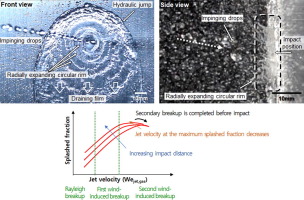当前位置:
X-MOL 学术
›
Exp. Therm. Fluid Sci.
›
论文详情
Our official English website, www.x-mol.net, welcomes your feedback! (Note: you will need to create a separate account there.)
Experimental study on splash phenomena of liquid jet impinging on a vertical wall
Experimental Thermal and Fluid Science ( IF 3.2 ) Pub Date : 2020-08-01 , DOI: 10.1016/j.expthermflusci.2020.110111 Hyunsuh Kim , Hyunhun Choi , Daegil Kim , Jaewon Chung , Hyojun Kim , Kihyun Lee
Experimental Thermal and Fluid Science ( IF 3.2 ) Pub Date : 2020-08-01 , DOI: 10.1016/j.expthermflusci.2020.110111 Hyunsuh Kim , Hyunhun Choi , Daegil Kim , Jaewon Chung , Hyojun Kim , Kihyun Lee

|
Abstract In this study, the splash phenomena of a plain orifice jet impinging on a vertical wall were examined. Experiments were carried out by changing the jet speed (i.e., inlet pressure) and the distance of a vertical wall with rounded and sharp-edged nozzles of different diameters, and the splashed fraction was measured by weighing the mass drained on the vertical wall. In addition, the breakup of the liquid jet and the flow patterns resulting from the jet impinging on the vertical wall were visualized. By increasing the velocity of a liquid jet emerging from a rounded nozzle, the Rayleigh, first wind-induced, and second wind-induced regimes could be observed in order. For the cavitating jet, the jet velocity became significantly larger than the volume flow rate divided by the nozzle area. Nevertheless, the trends of jet breakup as well as the splashed fraction results between the rounded and sharp-edged nozzles were similar for the same jet velocity. The splashed fraction reached its maximum value when small droplets resulted from the secondary breakup of large fragments started impinging on the vertical wall. In addition, the jet velocity at which the maximum splashed fraction attained decreased with increasing distance of the vertical wall from the nozzle exit. These experimental results were explained qualitatively in terms of the conditions of the liquid jet, breakup regime, drop impact, and splashing phenomena.
中文翻译:

液体射流撞击垂直壁面飞溅现象的实验研究
摘要 在这项研究中,研究了平孔射流撞击垂直壁的飞溅现象。通过改变射流速度(即入口压力)和具有不同直径的圆形和锐边喷嘴的垂直壁的距离来进行实验,并且通过称量在垂直壁上排出的质量来测量飞溅分数。此外,液体射流的破裂和射流撞击垂直壁产生的流动模式也被可视化。通过增加从圆形喷嘴射出的液体射流的速度,可以依次观察瑞利、第一风诱导和第二风诱导状态。对于空化射流,射流速度变得明显大于体积流量除以喷嘴面积。尽管如此,对于相同的射流速度,圆形和锋利边缘喷嘴之间的射流分裂趋势以及飞溅分数结果相似。当大碎片二次破碎产生的小液滴开始撞击垂直壁时,飞溅分数达到最大值。此外,获得最大飞溅分数的射流速度随着垂直壁距喷嘴出口的距离的增加而降低。这些实验结果定性地解释了液体射流的条件、破碎状态、下落撞击和飞溅现象。当大碎片二次破碎产生的小液滴开始撞击垂直壁时,飞溅分数达到最大值。此外,获得最大飞溅分数的射流速度随着垂直壁距喷嘴出口的距离的增加而降低。这些实验结果定性地解释了液体射流的条件、破碎状态、下落撞击和飞溅现象。当大碎片二次破碎产生的小液滴开始撞击垂直壁时,飞溅分数达到最大值。此外,获得最大飞溅分数的射流速度随着垂直壁距喷嘴出口的距离的增加而降低。这些实验结果定性地解释了液体射流的条件、破碎状态、下落冲击和飞溅现象。
更新日期:2020-08-01
中文翻译:

液体射流撞击垂直壁面飞溅现象的实验研究
摘要 在这项研究中,研究了平孔射流撞击垂直壁的飞溅现象。通过改变射流速度(即入口压力)和具有不同直径的圆形和锐边喷嘴的垂直壁的距离来进行实验,并且通过称量在垂直壁上排出的质量来测量飞溅分数。此外,液体射流的破裂和射流撞击垂直壁产生的流动模式也被可视化。通过增加从圆形喷嘴射出的液体射流的速度,可以依次观察瑞利、第一风诱导和第二风诱导状态。对于空化射流,射流速度变得明显大于体积流量除以喷嘴面积。尽管如此,对于相同的射流速度,圆形和锋利边缘喷嘴之间的射流分裂趋势以及飞溅分数结果相似。当大碎片二次破碎产生的小液滴开始撞击垂直壁时,飞溅分数达到最大值。此外,获得最大飞溅分数的射流速度随着垂直壁距喷嘴出口的距离的增加而降低。这些实验结果定性地解释了液体射流的条件、破碎状态、下落撞击和飞溅现象。当大碎片二次破碎产生的小液滴开始撞击垂直壁时,飞溅分数达到最大值。此外,获得最大飞溅分数的射流速度随着垂直壁距喷嘴出口的距离的增加而降低。这些实验结果定性地解释了液体射流的条件、破碎状态、下落撞击和飞溅现象。当大碎片二次破碎产生的小液滴开始撞击垂直壁时,飞溅分数达到最大值。此外,获得最大飞溅分数的射流速度随着垂直壁距喷嘴出口的距离的增加而降低。这些实验结果定性地解释了液体射流的条件、破碎状态、下落冲击和飞溅现象。



























 京公网安备 11010802027423号
京公网安备 11010802027423号